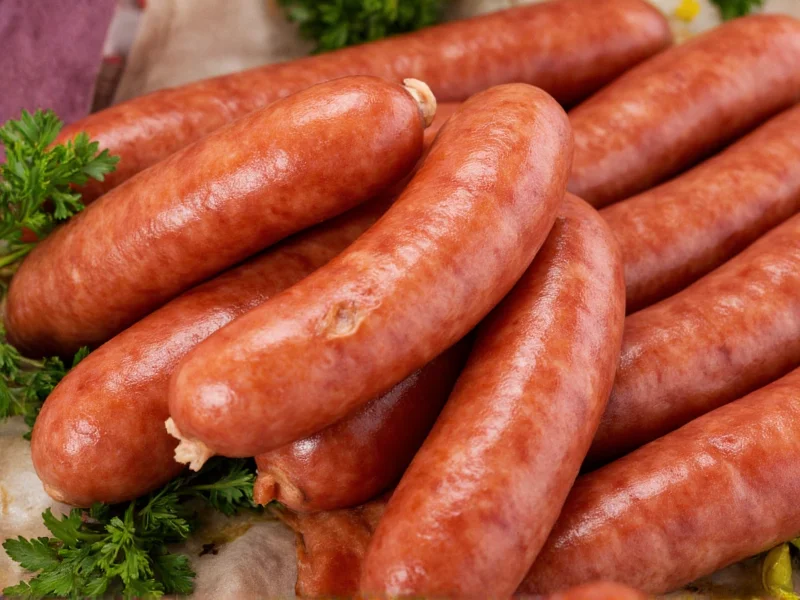When exploring the world of sausages, understanding the different types of sausage links available helps home cooks and culinary enthusiasts make informed choices for their recipes and meals. Sausage links refer to individual portions of sausage connected in a continuous chain, distinguished from bulk sausage that lacks pre-formed links.
Understanding Sausage Links Terminology
The term "sausage links" specifically describes sausages that have been formed into connected individual portions, typically twisted at regular intervals. This format makes portioning and cooking more convenient than working with bulk sausage. While all sausage links contain ground meat and seasonings encased in natural or synthetic casings, the specific ingredients and preparation methods create significant variations between types.
Most Common Types of Sausage Links
Various sausage link varieties have developed across different culinary traditions. The following represent the most widely available options in grocery stores and butcher shops throughout North America and Europe.
| Type of Sausage Link | Key Ingredients | Flavor Profile | Common Uses |
|---|---|---|---|
| Breakfast Sausage Links | Pork, sage, thyme, black pepper | Herbaceous, mildly spiced | Morning meals, biscuits and gravy |
| Italian Sausage Links | Pork, fennel, garlic, red/black pepper | Robust, aromatic, spicy or sweet | Pasta dishes, sandwiches, grilling |
| Bratwurst | Pork/beef/veal, nutmeg, ginger, mace | Rich, savory, slightly sweet | Grilling, sauerkraut pairing, beer festivals |
| Kielbasa/Polish Sausage | Pork/beef, garlic, marjoram, smoke | Smoky, garlicky, robust | Stews, casseroles, grilled with peppers |
| Chorizo | Pork, smoked paprika, garlic, vinegar | Spicy, smoky, tangy | Tapas, bean dishes, rice preparations |
| Andouille | Pork, garlic, pepper, smoked | Intensely smoky, spicy | Gumbos, jambalaya, Cajun cuisine |
| Frankfurters/Hot Dogs | Beef/pork, salt, curing agents | Mild, salty, smoky | Quick meals, sporting events, street food |
Breakfast Sausage Links Explained
Breakfast sausage links represent one of the most popular morning protein options in American cuisine. These pork-based links typically feature a blend of sage, thyme, and black pepper that creates their distinctive flavor profile. Unlike other sausage varieties, breakfast links generally contain no garlic or fennel, focusing instead on earthy herb notes that complement eggs and pancakes.
When selecting breakfast sausage links, look for products with minimal fillers and preservatives. High-quality versions contain 70-80% lean meat with breadcrumbs or other binders making up the remainder. Properly cooked breakfast sausage links should reach an internal temperature of 160°F (71°C) and develop a golden-brown exterior while remaining juicy inside.
Italian Sausage Links: Sweet vs. Hot
Italian sausage links come in two primary varieties: sweet and hot. Both versions feature fennel as the dominant spice, but hot Italian sausage includes red pepper flakes for additional heat. The pork base in quality Italian sausage links should contain visible pieces of fat (approximately 25-30%) that melt during cooking, basting the meat internally.
Chefs specializing in Italian cuisine recommend removing Italian sausage links from their casings when making sauces, as this allows the flavorful meat to integrate better with other ingredients. For grilling or pan-searing, keep the casings intact to maintain the link shape and create that desirable crispy exterior.
Regional Sausage Link Varieties
Beyond the most common types, numerous regional sausage link varieties exist worldwide. German bratwurst differs significantly from American versions, often containing more veal and milder seasonings. Spanish chorizo varies from Mexican chorizo in both preparation (cured vs. fresh) and ingredients.
In the Southern United States, you'll find unique regional specialties like Cajun smoked sausage, which combines elements of andouille and kielbasa with distinctive local spice blends. Scandinavian countries feature their own link varieties, such as the Danish medisterpølse, made with a higher fat content and caraway seeds.
How Sausage Links Are Made
The process of creating sausage links involves forcing seasoned ground meat through a casing tube, then twisting the casing at regular intervals to form individual portions. Traditional methods use natural casings made from animal intestines, while many commercial products use collagen or cellulose casings.
Proper linking technique ensures consistent portion sizes and prevents air pockets that could cause bursting during cooking. Artisanal sausage makers often hand-link their products, while large-scale operations use automated machinery that can produce thousands of links per hour while maintaining uniformity.
Cooking Methods for Different Sausage Links
Each sausage link variety responds best to specific cooking techniques. Breakfast sausage links benefit from gentle pan-frying over medium heat to render fat slowly. Italian sausage links achieve optimal results when first boiled briefly to cook through, then finished on the grill for char marks.
Bratwurst traditionally undergoes a two-step process: simmering in beer until cooked through, then grilling to develop flavor. Andouille and kielbasa work well in slow-cooked dishes where their robust flavors can permeate other ingredients. Always use a meat thermometer to verify that sausage links reach safe internal temperatures before serving.
Selecting Quality Sausage Links
When purchasing sausage links, examine the ingredient list for minimal additives and preservatives. High-quality products typically contain recognizable ingredients with meat listed as the primary component. Avoid products where water, fillers, or artificial ingredients appear near the beginning of the ingredient list.
Fresh sausage links should feel firm to the touch with no slimy texture. The color should be consistent throughout, without gray or brown spots that indicate oxidation. For pre-cooked varieties like hot dogs, check expiration dates carefully and choose products with simpler ingredient profiles when possible.











 浙公网安备
33010002000092号
浙公网安备
33010002000092号 浙B2-20120091-4
浙B2-20120091-4